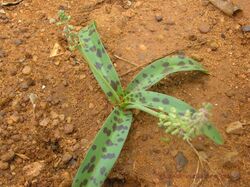Biology:Ledebouria revoluta
| Ledebouria revoluta | |
|---|---|

| |
| Scientific classification | |
| Kingdom: | Plantae |
| Clade: | Tracheophytes |
| Clade: | Angiosperms |
| Clade: | Monocots |
| Order: | Asparagales |
| Family: | Asparagaceae |
| Subfamily: | Scilloideae |
| Genus: | Ledebouria |
| Species: | L. revoluta
|
| Binomial name | |
| Ledebouria revoluta (L.f.) Jessop 1970[1]
| |
| Synonyms | |
| |
Ledebouria revoluta, the south Indian squill, is a flowering plant species in the genus Ledebouria found in Southern Africa and India.
In Africa some tribes consume the bulbs of L. revoluta. It is widely used as an ethnomedicinal in Southern Africa. Homoisoflavanones can be isolated from the bulbs of L. revoluta.[2] In India, this species is commonly known as ‘Indian squill’ or ‘jangali pnyaaj’ (wild onion), and fresh squill yields several cardiac glycosides—Scillarin-A, Scillarin-B, 3-benzyl-4-chromanones, Scillarenin bis-L-rhamnoside, etc. and therefore known as a cardioprotective plant.[3] The scaly bulb of L. revoluta had potential antibacterial (against both Gram-positive and Gram-negative bacteria) and antifungal activity.[4]
Tissue culture
Micropropagation of Ledebouria revoluta through callus culture and indirect somatic embryogenesis[3] as well as shoot organogenesis[4] was well established. Artificial seeds technology was successfully performed by alginate-encapsulation of this somatic embryos.[3]
Cytology
Detail cytological studies of sporophytic and gametophytic generation of Ledebouria revoluta was made by Haque and Ghosh (2016).[5] Meiotic studies revealed 15 bivalents in L. revoluta, which confirms their diploid numbers 2n = 30. Diploid karyotype as well as haploid karyotype was studied from somatic cells and pollen grains respectively.[5]
Etymology
Ledebouria is named for Carl Friedrich von Ledebour (1785-1851),[6] a botanist who published, among other things, the first complete Russia n flora. [7]
References
- ↑ Journal of South African Botany. Kirstenbosch 36:255. 1970
- ↑ 3-Benzyl-4-chromanones (homoisoflavanones) from bulbs of the ethnomedicinal geophyte Ledebouria revoluta (Hyacinthaceae). N. Moodley, N.R. Crouch, D.A Mulholland, D. Slade and D. Ferreira, South African Journal of Botany, January 2006; 72(4):517-520. doi:10.1016/j.sajb.2006.01.004
- ↑ 3.0 3.1 3.2 Haque SM, Ghosh B. (2016) High-frequency somatic embryogenesis and artificial seeds for mass production of true-to-type plants in Ledebouria revoluta: an important cardioprotective plant. Plant Cell, Tissue and Organ Culture. Volume 127, Issue 1, pp 71–83. https://doi.org/10.1007/s11240-016-1030-5
- ↑ 4.0 4.1 Haque SM, Avijit Chakraborty, Ghosh B. (2018) Callus mediated shoot organogenesis and regeneration of cytologically stable plants of Ledebouria revoluta: an ethnomedicinal plant with promising antimicrobial potency. Journal of Genetic Engineering and Biotechnology. Volume 16, Issue 2, Pages 645-651. https://doi.org/10.1016/j.jgeb.2018.05.002
- ↑ 5.0 5.1 Haque SM, Ghosh B. (2016) Cytological studies of sporophytic and gametophytic generation of two bulbaceous species Ledebouria revoluta and Drimiopsis botryoides (Asparagaceae). Caryologia. Volume 69, Issue 1, Pages 38-49. https://doi.org/10.1080/00087114.2015.1109940
- ↑ Gledhill, David (2008). "The Names of Plants". Cambridge University Press. ISBN:9780521866453 (hardback), ISBN:9780521685535 (paperback). pp 232
- ↑ "Flora Rossica". Biodiversity Heritage Library. 1842. https://www.biodiversitylibrary.org/bibliography/6606#/summary.
External links
Wikidata ☰ Q15520486 entry

